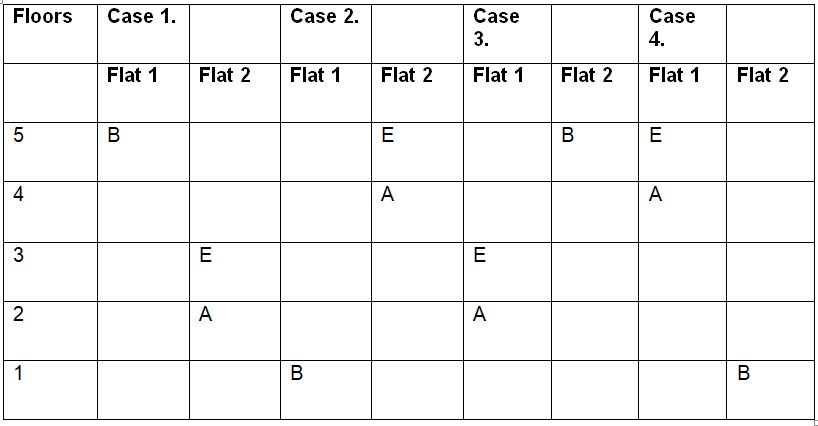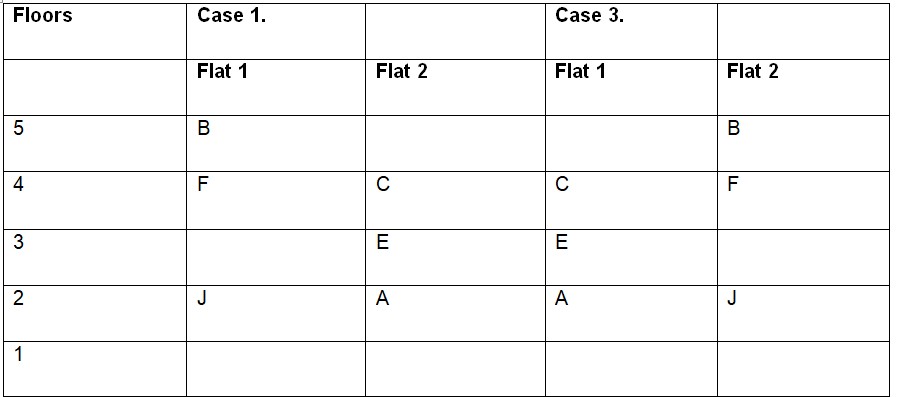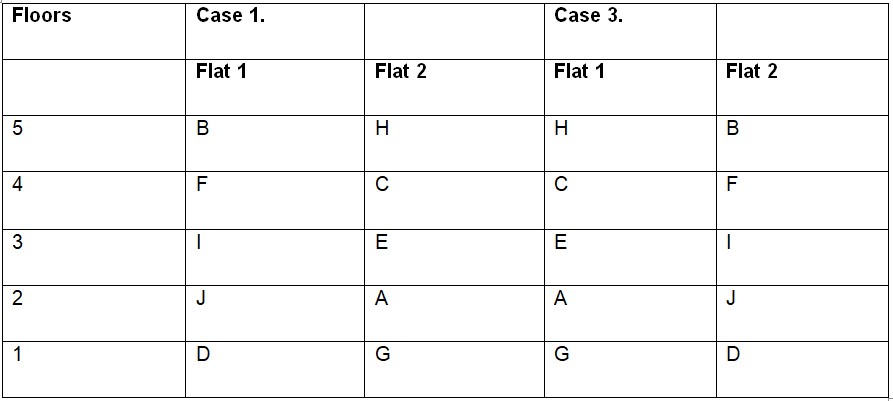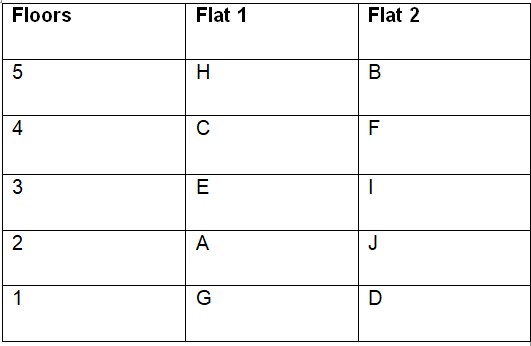Question
Who among the following lives in flat-2 of 4th
floor? Study the following information carefully to answer the given questions: Ten persons A, B, C, D, E, F, G, H, I and J are living in a five storey building such that ground floor is numbered as 1, above it is floor 2 then top floor is numbered as 5. Each of the floor has 2 flats in it as flat-1 and flat-2. Flat-1 of floor-2 is immediately above flat-1 of floor-1 and immediately below flat-1 of floor-3 and so on. In the same way flat-2 of floor-2 is immediately above flat-2 of floor-1 and immediately below flat-2 of floor-3 and so on. Flat-1 is in west of flat-2. B lives in an odd numbered floor. Both E and G lives in the same flat number. C and F live in the same floor. H does not live in flat number 2. There is a gap of two floors in which B and A lives. Both A and B do not live in the same flat number. E lives immediately above A in the same flat number. There is a gap of one floor in which E and G lives. J, who lives on an even numbered floor, lives below F and both lives in the same flat number. I lives above D and both live in the same flat number. H and D neither live in the same flat number nor in the same floor.Solution
B lives in an odd numbered floor. There is a gap of two floors in which B and A lives. Both A and B do not live in the same flat number. E lives immediately above A in the same flat number. From these statements we will have four cases: If B lives on fifth floor in flat 1, then A lives on second floor in flat 2. As E lives immediately above A in the same flat number. So, E will live on third floor in flat 2. If B lives on first floor in flat 1, then A lives on fourth floor in flat 2. As E lives immediately above A in the same flat number. So, E will live on fifth floor in flat 2. If B lives on fifth floor in flat 2, then A lives on second floor in flat 1. As E lives immediately above A in the same flat number. So, E will live on third floor in flat 1. If B lives on first floor in flat 2, then A lives on fourth floor in flat 1. As E lives immediately above A in the same flat number. So, E will live on fifth floor in flat 1.  Both E and G lives in the same flat number.C and F live in the same floor. (vi) J, who lives on an even numbered floor, lives below F and both lives in the same flat number. From these statements Case 2 and Case 4 will get discarded as G lives on third floor. C and F live on same floor and J lives below F in even number floor which can’t be possible. So, we will proceed with Case 1 and Case 3. Case 1. F cannot live on fourth floor in flat 2 as J lives below F in even number floor. So, F and C will live on fourth floor in flat 1 and flat 2 respectively. Then J lives on second floor in flat 1. Case 3. F cannot live on fourth floor in flat 1 as J lives below F in even number floor. So, F and C will live on fourth floor in flat 2 and flat 1 respectively. Then J lives on second floor in flat 2.
Both E and G lives in the same flat number.C and F live in the same floor. (vi) J, who lives on an even numbered floor, lives below F and both lives in the same flat number. From these statements Case 2 and Case 4 will get discarded as G lives on third floor. C and F live on same floor and J lives below F in even number floor which can’t be possible. So, we will proceed with Case 1 and Case 3. Case 1. F cannot live on fourth floor in flat 2 as J lives below F in even number floor. So, F and C will live on fourth floor in flat 1 and flat 2 respectively. Then J lives on second floor in flat 1. Case 3. F cannot live on fourth floor in flat 1 as J lives below F in even number floor. So, F and C will live on fourth floor in flat 2 and flat 1 respectively. Then J lives on second floor in flat 2.  H does not live in flat number 2.There is a gap of one floor in which E and G lives. I lives above D and both live in the same flat number. H and D neither live in the same flat number nor in the same floor. Case 1. I and D cannot live in flat 2 as there is a gap of one floor in which E and G lives. So, I and D will live on third floor and first floor in flat 1. H and D neither live in the same flat number nor in the same floor. H cannot live on first floor with D. So, H live son fifth floor in flat 2 but this case will get discarded as it is given that H does not live in flat number 2. Case 3. I and D cannot live in flat 1 as there is a gap of one floor in which E and G lives. So, I and D will live on third floor and first floor in flat 2. H and D neither live in the same flat number nor in the same floor. H cannot live on first floor with D. So, H live son fifth floor in flat 1 and G lives on first floor in flat 1.
H does not live in flat number 2.There is a gap of one floor in which E and G lives. I lives above D and both live in the same flat number. H and D neither live in the same flat number nor in the same floor. Case 1. I and D cannot live in flat 2 as there is a gap of one floor in which E and G lives. So, I and D will live on third floor and first floor in flat 1. H and D neither live in the same flat number nor in the same floor. H cannot live on first floor with D. So, H live son fifth floor in flat 2 but this case will get discarded as it is given that H does not live in flat number 2. Case 3. I and D cannot live in flat 1 as there is a gap of one floor in which E and G lives. So, I and D will live on third floor and first floor in flat 2. H and D neither live in the same flat number nor in the same floor. H cannot live on first floor with D. So, H live son fifth floor in flat 1 and G lives on first floor in flat 1.  Final arrangement as shown below:
Final arrangement as shown below: 
Match Column I and Column II and choose the correct match from the given choice
Match Column I and Column II and choose the correct match from the given choices
In the following questions two columns are given. In column-I three sentences are given, each of them consisting of a blank which may or may not be fil...
In the following question, a sentence is divided in to three parts, given in column 1, 2 and 3. Match the statements from column 1 with those in column...
In the following questions two columns are given. In column-I three sentences are given, each of them consisting of a blank which may or may not be fil...
Directions: Match the words in Column A with their meanings in Column B, and choose the correct combination from the options given below:
...BUT
In the following question, two columns are given, containing three phrases each. A phrase from the first column may or may not connect with a phrase fr...
Relevant for Exams:


